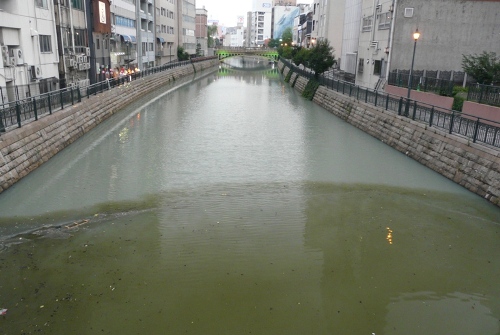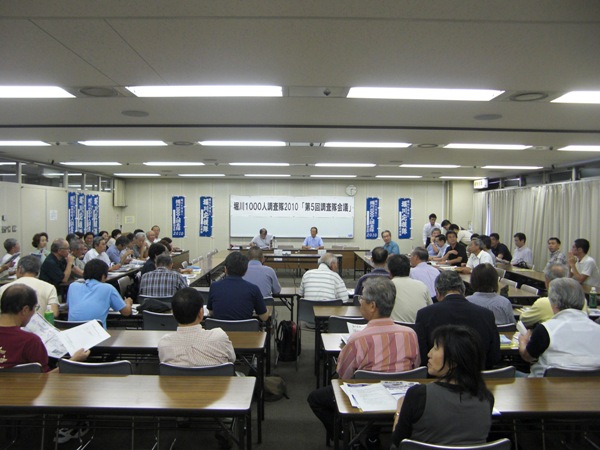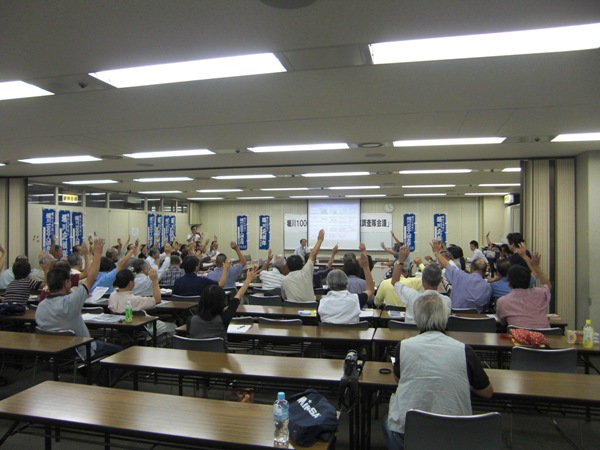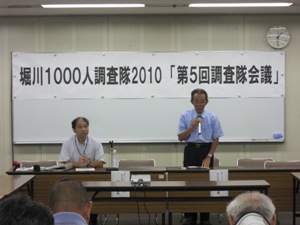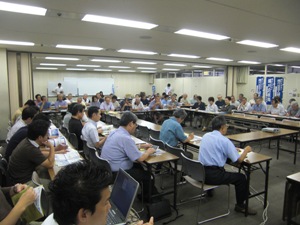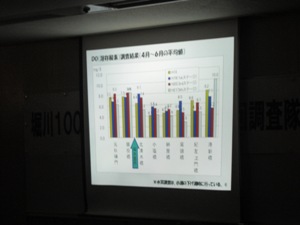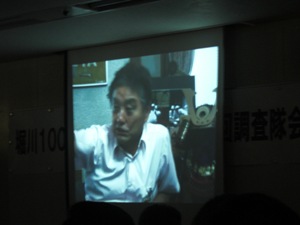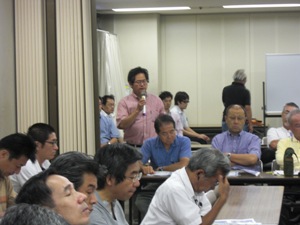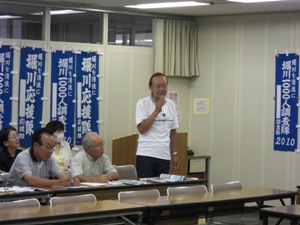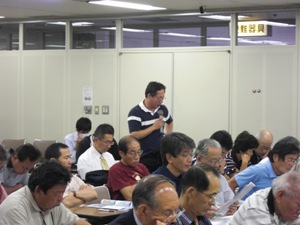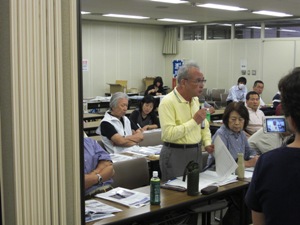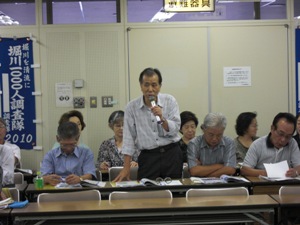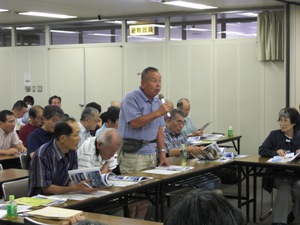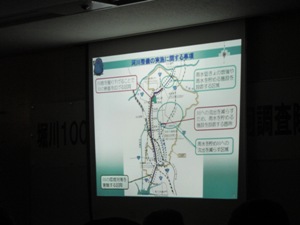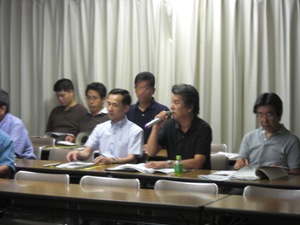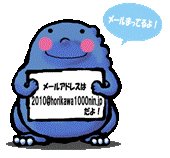|
|
Activities of Fifth Stage |
||||||||||||||||||||||||||||||||||||||||||||||||||||||||||||||||||||||||||||||||
|
|
|
||||||||||||||||||||||||||||||||||||||||||||||||||||||||||||||||||||||||||||||||
|
|
On September 27th 2009, the 5th survey groups’ conference of Horikawa-Sennin Chosatai (HSC) was held at the Nagoya Trade and Industry center in Fukiage, Chikusa-ward.
When: September 27th 2009, 13:30-16:00 Where: the 3rd meeting room at 4F, the Nagoya Trade and Industry center |
||||||||||||||||||||||||||||||||||||||||||||||||||||||||||||||||||||||||||||||||
|
|
The purpose of this meeting were as follows:
(1) Summarizing the result of the survey by the citizen’s survey groups in the 5th stage from April to June, 2009. (2) Verifying that TRWKR brought what change to the HR in this 2 and half a year. (3) Discussions that how does it act as the citizens for the end of the social experiment after half a year, and how not only the investigations but also actual purification will and the cleanup campaign should be developed in future.
About 80 people from citizen’s survey groups
and administrative parties concerned and had some active discussions. Participants in the hall gave a sigh when
the citizens in the video said “As I thought, this river is stinky” or “The
transparency is bad, and the bottom of the river is dirty”. The participant was gazing quietly to the screen in the scene where the mayor said that “I think TRWKR should be continued, because the raw water transmission to the HR was important for the clarification. I will go to the Ministry of Land Infrastructure Transport and Tourism to ask”.
There was calling also, “Please participate
the cleaning activity that the Nagoya Horikawa
Lions Club will do in the vicinity of Matsushige-gate
at 9 AM on Octover 3”.
1. It has been understood that the state of the HR in the downstream of the Sanage Bridge is hourly changeable due to the rise and fall of the tide. A lot of observations which the fixed point observation groups did were a major breakthrough in clarification of the normal state of HR.
2. In the 5th stage, the average temperature was higher than the last 2 years. Moreover, changes in water level on the ebb tide were larger than two years in the past, and there were a lot of time zones that the water level at the ebb tide is lower. (There was a point that it might be also related that there was a total eclipse of the sun in July, though a scientific verification was necessary.) Therefore, as a feature, in the 5th stage there are phenomena that the water level of the HR is lower and the flow velocity is faster at the ebb tide and the flood tide than the last 2 years.
* There was not so much substantial change in the water level at the flood tide.
3. Because of these reasons, more phenomena that sludge exposed on the surface of the water at the ebb and sludge rolled in water and went up in the HR were seen more frequently in this year than the last 2 years. It was seemed that these phenomena influenced color of water, transparency, COD, smell, and bubbles, etc., and administrative survey and the citizens’ survey pointed out that the quality of the HR’s water was worse in this summer than the last summer. It seems that it was also a origin that the average temperatures in this year was higher than last year.
4. In the 5th stage, because the water level is low and the flow velocity was fast at the ebb tide, it was pointed out that smell had deteriorated especially in the central area between the Asahi Bridge and the Matsushige Bridge. Especially the ratio of “addled egg smell” has increased when the state like “blue tide” happen in the HR.
The phenomenon is called a blue tide that the surface of the water changes into milky-blue and the milky-white. If oxygen-deficient water can arise, because oxygen is deprived by resolving the organism, the sulphuric acid ion contained in it is reduced with the sulphate reducer that is anaerobic bacteria, and become a sulfide ion. Water that contains the sulfide ion generates the hydrogen sulfide that smells that the egg rots, and generates the corpuscle of sulfur and SOx by reacting with the oxygen in the atmosphere. This corpuscle drifts in water, reflects sunlight, and discolors the surface of the water to milky-blue and milky-white.
5. There were some improvements in water quality between the Sanage Bridge and Matushige Bridge in the HR. These improvements are presumed to be due to the effects of TRWKR, etc. The improved area tabulates as follows.
・Impression of appearance was improved between the Matsusige Bridge and the Sanage Bridge. ・Transparency was improved between the Matsusige Bridge and the Sanage Bridge. ・COD was improved between the Ohseko Bridge and the Sanage Bridge. ・Bubbles were improved in midstream and upstream area. ・Smell was improved between the Asahi Bridge and the Sanage Bridge. Improvements were not seen in town midstream area. Especially, smell between the Asahi Bridge and the Matususige Bridge is worse than other area.
・Impression of appearance was improved almost of all area in the HR. ・Transparency was improved between the Ohseko Bridge and the Johoku Bridge. Change of transparency was not seen because it in upstream area is good at all times. ・COD was improved on the day with TRWKR between the Asahi Bridge and the Sanage Bridge. Unfortunately, the improvement by TRWKR was not able to be confirmed in the lower reaches of central urban area.
6. It was clarified that the water quality of the HR was worse in the period from spring to early summer (from April to June) than from autumn to winter (from September to December). The following factors will be considered as reason. (1) Because the temperature of the HR comes to be higher in summer time, contamination (organism etc.) tends to melt to water and increase easily. (2) In summer, the water level at the daytime ebb tide is lower than that of the nighttime ebb tide. In winter, the water level at the daytime ebb tide is higher than that of the nighttime ebb tide by contrast. Since the survey is mainly done in daytime; the condition is worse in summer than winter despite at same ebb tide. On the other hand, it is guessed as the reflection in data that the winter survey is done with good condition compared with summer time. The investigation in summer easily receives the influence of the tide (colloidal sediment circulation etc.), because the water level at the ebb tide is low. Therefore, the survey data in summer is thought to be more disadvantageous than winter.
7. Artificial garbage that floated on the HR was roughly in the decreasing tendency. However, the confirmation frequency of garbage has increased in down-midstream area (from the Matsusige Bridge to the Oseko Bridge). The garbage of the plastic and paper containers has increased.
8. On the road, the frequency of the garbage in which the cigarette butt is seen is high. On the other hand, the decreasing tendency is seen in the plastic bag, plastic bag with the garbage, the empty cans, newspaper, and the wrapping paper of cigarettes.
9. The decrease of the garbage floating on the HR and the garbage on the road is thought that the change in a social environment including the charge on plastic bag in addition to the awareness of the citizens that it wants to clean the HR (effects of the cleanup activity and the on-site training, etc.) influences.
10. The living things in the HR. It was confirmed at the Koshio Bridge that a lot of young fishes of the mullet (the estuarine water fish・Eggs is laid in the sea) which it was born this year had passed ran up. Comparatively speaking, the frequency of the report in which the young fish of mullet was seen at the span from the Habashita Bridge to the Nayabashi Bridge was increased this year.
|
||||||||||||||||||||||||||||||||||||||||||||||||||||||||||||||||||||||||||||||||
|
|
|
||||||||||||||||||||||||||||||||||||||||||||||||||||||||||||||||||||||||||||||||
|
|
Also, Mr. Yamada announced about progressed waste water treatment in the Meijyo water treatment center, prepared as Nagoya City, and progress of construction work of underground rainwater storage tank both side of the HR. About the exchange activity of upper and lower the Kiso River, progressing achievement of internet exchange congress in last year, setting up of the drop shipment shop of the Kiso River basin in Jyoshin is planned. Whole the clarification or revival activities of urban rivers in Japan, no other case can be seen compare with HSC; citizens organize survey groups, write such detail reports up, progress awareness activities and cleanup campaigns utilizing network. Also, such approach, administration, citizens, universities, and companies combine and work together, has unique progressing, then we can proud of it as the Nagoya citizen. Driving hearts and carrying abilities out steadily, then sustained approach for revival of limpid stream of the HR should be amazing…
|
||||||||||||||||||||||||||||||||||||||||||||||||||||||||||||||||||||||||||||||||
|
|
|
||||||||||||||||||||||||||||||||||||||||||||||||||||||||||||||||||||||||||||||||
